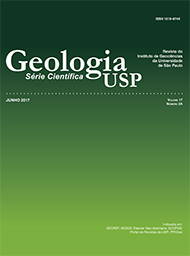Primary and secondary Fe and Mn phosphates in granitic pegmatites from the Mata Azul Pegmatitic Field, Jaú do Tocantins, TO, Brazil
DOI:
https://doi.org/10.11606/issn.2316-9095.v17-121274Keywords:
Fe-Mn phosphates, Pegmatites, Mata Azul.Abstract
In central Brazil, in the southern Tocantins and in the northern Goiás States, barren and mineralized granitic pegmatites are known and explored for a long time, but only in recent years they were properly characterized and grouped in the so called Mata Azul Pegmatitic Field. In Jaú do Tocantins, three of the pegmatite bodies explored for beryl, a Fe-Mn phosphate associations occur as centimetric nodules and aggregates. Two phosphate associations were characterized: the first, hosted in Pichorra and São Júlio pegmatites present three primary phases, identified as zwieselite, sarcopside and fluorapatite. Hydrothermal processes transform the primary phosphates in rockbridgeite, heterosite and a phase of the alluaudite subgroup. The second association was observed in the Fazenda Mesquita pegmatite, where primary phosphates are absent and orange to green rockbridgeite is the main phase, followed by phosphosiderite and strengite formed by the weathering of rockbridgeite. In both associations, the weathering of the Fe-Mn phosphates give rise to Fe and Mn oxides. Minor phases as uraninite, gahnite, almandine and columbite-(Fe) were identified as inclusions in the phosphate phases.
Downloads
Downloads
Published
Issue
Section
License
Authors who publish in this journal shall comply with the following terms:
- Authors keep their copyright and grant to Geologia USP: Série Científica the right of first publication, with the paper under the Creative Commons BY-NC-SA license (summary of the license: https://creativecommons.org/licenses/by-nc-sa/4.0 | full text of the license: https://creativecommons.org/licenses/by-nc-sa/4.0/legalcode) that allows the non-commercial sharing of the paper and granting the proper copyrights of the first publication in this journal.
- Authors are authorized to take additional contracts separately, for non-exclusive distribution of the version of the paper published in this journal (publish in institutional repository or as a book chapter), granting the proper copyrights of first publication in this journal.
- Authors are allowed and encouraged to publish and distribute their paper online (in institutional repositories or their personal page) at any point before or during the editorial process, since this can generate productive changes as well as increase the impact and citation of the published paper (See The effect of Open Access and downloads on citation impact).





